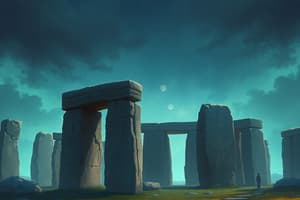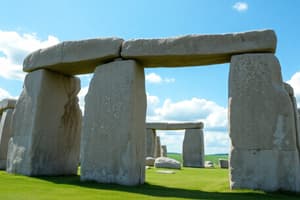Podcast
Questions and Answers
What is Stonehenge?
What is Stonehenge?
- A prehistoric monument located in Wiltshire, England (correct)
- A medieval castle in Scotland
- A natural rock formation in Wales
- A modern art installation in London
When was Stonehenge constructed?
When was Stonehenge constructed?
- Around 1000 AD to 1500 AD
- Around 3000 BC to 2000 BC (correct)
- Around 500 BC to 100 BC
- Around 1700 BC to 1300 BC
What is the purpose of Stonehenge?
What is the purpose of Stonehenge?
- Astronomical observatory
- Remains subject to debate (correct)
- All of the above
- Religious site
Who owns Stonehenge?
Who owns Stonehenge?
What is the origin of the name Stonehenge?
What is the origin of the name Stonehenge?
When was Stonehenge added to UNESCO's list of World Heritage Sites?
When was Stonehenge added to UNESCO's list of World Heritage Sites?
What is the last known construction at Stonehenge?
What is the last known construction at Stonehenge?
Who were the Bell Beaker people?
Who were the Bell Beaker people?
What is the Wessex people associated with?
What is the Wessex people associated with?
Flashcards
What is Stonehenge?
What is Stonehenge?
Stonehenge is a prehistoric monument in England, consisting of an outer ring of vertical sarsen stones and an inner ring of smaller bluestones, built around 3000 BC to 2000 BC.
How was Stonehenge built?
How was Stonehenge built?
Stonehenge's construction involved several phases spanning over 1500 years, starting with an early circular bank and ditch enclosure, followed by the addition of bluestones and later, massive sarsen stones.
What does "Stonehenge" mean?
What does "Stonehenge" mean?
The name Stonehenge comes from Old English words "stān" meaning "stone" and "hencg" meaning "hinge", referring to the way the stone lintels rest on the upright stones.
What is special about Stonehenge's alignment?
What is special about Stonehenge's alignment?
Signup and view all the flashcards
Why is Stonehenge important?
Why is Stonehenge important?
Signup and view all the flashcards
Who built Stonehenge?
Who built Stonehenge?
Signup and view all the flashcards
What was the purpose of Stonehenge?
What was the purpose of Stonehenge?
Signup and view all the flashcards
How were the sarsen stones moved?
How were the sarsen stones moved?
Signup and view all the flashcards
What have archaeologists discovered at Stonehenge?
What have archaeologists discovered at Stonehenge?
Signup and view all the flashcards
Study Notes
Stonehenge: A Detailed Summary
-
Stonehenge is a prehistoric monument located in Wiltshire, England, consisting of an outer ring of vertical sarsen standing stones and a ring of smaller bluestones inside.
-
Archaeologists believe it was constructed from around 3000 BC to 2000 BC, with the earliest phase, a circular earth bank and ditch, dated to about 3100 BC.
-
Stonehenge is a British cultural icon, legally protected since 1882, and added to UNESCO's list of World Heritage Sites in 1986. It is owned by the Crown and managed by English Heritage.
-
The site is aligned towards the sunrise on the summer solstice and set within earthworks in the middle of the densest complex of Neolithic and Bronze Age monuments in England.
-
Stonehenge could have been a burial ground from its earliest beginnings, with deposits containing human bone dating from as early as 3000 BC.
-
The name Stonehenge comes from the Old English words stān meaning "stone", and either hencg meaning "hinge" (because the stone lintels hinge on the upright stones) or hen(c)en meaning "to hang" or "gallows".
-
Stonehenge is atypical of Neolithic henges and stone circles, with extant trilithons' lintels held in place with mortise and tenon joints, making it unique.
-
Stonehenge evolved in several construction phases spanning at least 1500 years, with evidence of large-scale construction on and around the monument that perhaps extends the landscape's time frame to 6500 years.
-
The first monument consisted of a circular bank and ditch enclosure made of Late Cretaceous Seaford chalk, measuring about 360 feet in diameter, with a large entrance to the north east and a smaller one to the south.
-
The second phase of construction occurred approximately between 2900 and 2600 BC, with the number of postholes dating to the early third millennium BC suggesting that some form of timber structure was built.
-
Around 2600 BC, the builders abandoned timber in favour of stone and dug two concentric arrays of holes (the Q and R Holes) in the centre of the site, which held up to 80 standing stones.
-
The stones, which weighed about two tons, could have been moved by lifting and carrying them on rows of poles and rectangular frameworks of poles. It is not known whether the stones were taken directly from their quarries to Salisbury Plain or were the result of the removal of a venerated stone circle from Preseli to Salisbury Plain.Stonehenge: A Timeline of Construction and Function
-
Stonehenge was built in several phases over a period of around 1500 years.
-
The earliest phase, Stonehenge 1, dates back to around 3000 BC and consisted of a circular ditch and bank with 56 pits known as the Aubrey Holes.
-
During Stonehenge 2 (around 2900 BC), a circle of bluestones was erected inside the ditch and bank.
-
In Stonehenge 3 I (around 2600 BC), the bluestones were rearranged and a small circle of sarsen stones was erected outside the ditch and bank.
-
Stonehenge 3 II (around 2600-2400 BC) saw the arrival of 30 enormous sarsen stones, which were dressed and fashioned with mortise and tenon joints before being erected as a circle with a ring of lintel stones resting on top.
-
Five trilithons of dressed sarsen stone were also arranged in a horseshoe shape within the circle.
-
Stonehenge 3 III (around 2400-2280 BC) saw the bluestones re-erected within the outer sarsen circle.
-
Stonehenge 3 IV (around 2280-1930 BC) saw further rearrangement of the bluestones, which were arranged in a circle between the two rings of sarsens and in an oval at the centre of the inner ring.
-
Stonehenge 3 V (around 1930-1600 BC) saw the northeastern section of the bluestone circle removed, creating a horseshoe-shaped setting.
-
The Y and Z Holes, built around 1600 BC, are the last known construction at Stonehenge, and the last usage of it was probably during the Iron Age.
-
The purpose of Stonehenge remains subject to debate, with proposed functions including usage as an astronomical observatory, a religious site, a place of healing, and a symbol of peace and unity.
-
DNA studies reveal that the ancestors of the people who built Stonehenge were early European farmers who came from the Eastern Mediterranean and Western hunter-gatherers from western Europe, with a predominantly Aegean ancestry.Stonehenge: A Summary
-
Neolithic individuals in the British Isles had about 75% ancestry from Aegean farmers with the rest coming from Western Hunter-Gatherers in continental Europe.
-
The Neolithic farmers in Britain had paternal (Y-DNA) lineages that were almost exclusively of Western Hunter-Gatherer origin.
-
The Bell Beaker people arrived later, around 2,500 BC, migrating from mainland Europe and replacing more than 90% of Britain's Neolithic gene pool.
-
The Bell Beakers were associated with the tin trade, which was Britain's only unique export at the time.
-
The Wessex people, associated with the Bell Beakers, had wide-ranging trade links with continental Europe.
-
There is evidence to suggest that cereal cultivation fell out of favor in the British Isles between 3300 and 1500 BC, with much of the population reverting to a pastoralist subsistence pattern.
-
Stonehenge was bought by Cecil Chubb in 1915 for £6,600 (£562,700 in 2023) and given to the nation three years later.
-
Stonehenge was closed to festivalgoers by a High Court injunction after the Stonehenge Free Festival between 1972 and 1984.
-
Stonehenge's setting has been affected by the proximity of the A344 to Shrewton on the north side and the A303 to Winterbourne Stoke to the south.
-
Plans to upgrade the A303 and close the A344 to restore the vista from the stones have been considered since the monument became a World Heritage Site.
-
On 20 January 2010, Wiltshire Council granted planning permission for a centre 1.5 mi (2.4 kilometres) to the west and English Heritage confirmed that funds to build it would be available, supported by a £10m grant from the Heritage Lottery Fund.
-
Stonehenge and its surrounding monuments have attracted attention from antiquarians and archaeologists throughout recorded history.The History of Stonehenge: From Excavations to Discoveries
-
Stone 22 fell during a storm on December 31, 1900.
-
William Gowland oversaw the first major restoration of the monument in 1901, which involved the straightening and concrete setting of sarsen stone number 56.
-
In 1966 and 1967, the area of land immediately northwest of the stones was excavated by Faith and Lance Vatcher, who discovered the Mesolithic postholes dating from between 7000 and 8000 BC.
-
In 1993, the way that Stonehenge was presented to the public was called 'a national disgrace' by the House of Commons Public Accounts Committee.
-
More recent excavations include a series of digs held between 2003 and 2008 known as the Stonehenge Riverside Project, led by Mike Parker Pearson.
-
In April 2008, Tim Darvill and Geoff Wainwright began another dig inside the stone circle to retrieve datable fragments of the original bluestone pillars.
-
In 2010, the Stonehenge Hidden Landscape Project discovered a "henge-like" monument less than 0.62 mi (1 km) away from the main site.
-
In November 2011, archaeologists from the University of Birmingham announced the discovery of evidence of two huge pits positioned within the Stonehenge Cursus pathway.
-
In December 2011, geologists from the University of Leicester and the National Museum of Wales announced the discovery of the source of some of the rhyolite fragments found in the Stonehenge debitage.
-
In 2014, the University of Birmingham announced findings including evidence of adjacent stone and wooden structures and burial mounds near Durrington, that may date as far back as 4000 BC.
-
In November 2020, a plan to construct a four-lane tunnel for traffic below the site was approved.
-
In February 2021, archaeologists announced the discovery of "vast troves of Neolithic and Bronze Age artifacts" while conducting excavations for a proposed highway tunnel near Stonehenge.
-
In January 2022, archaeologists announced the discovery of thousands of prehistoric pits during an electromagnetic induction field survey around Stonehenge.
Studying That Suits You
Use AI to generate personalized quizzes and flashcards to suit your learning preferences.




